

PHYSICS MAP. Institute: Introduction to Zero-Point Energy. Why do electrons not fall into the nucleus? The picture of electrons "orbiting" the nucleus like planets around the sun remains an enduring one, not only in popular images of the atom but also in the minds of many of us who know better.
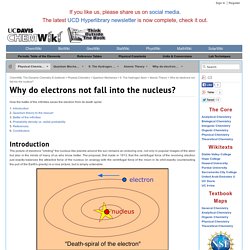
The proposal, first made in 1913, that the centrifugal force of the revolving electron just exactly balances the attractive force of the nucleus (in analogy with the centrifugal force of the moon in its orbit exactly counteracting the pull of the Earth's gravity) is a nice picture, but is simply untenable. An electron, unlike a planet or a satellite, is electrically charged, and it has been known since the mid-19th century that an electric charge that undergoes acceleration (changes velocity and direction) will emit electromagnetic radiation, losing energy in the process. The Stirling Generator. TOP TEN UNSOLVED PROBLEMS IN PHYSICS. A Boy And His Atom. A Boy And His Atom: The World's Smallest Movie. FLP Vol. I Table of Contents.
Einstein for Everyone. Einstein for Everyone Nullarbor Press 2007revisions 2008, 2010, 2011, 2012, 2013 Copyright 2007, 2008, 2010, 2011, 2012, 2013 John D.
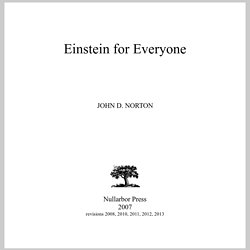
Norton Published by Nullarbor Press, 500 Fifth Avenue, Pittsburgh, Pennsylvania 15260 with offices in Liberty Ave., Pittsburgh, Pennsylvania, 15222 All Rights Reserved John D. An advanced sequel is planned in this series:Einstein for Almost Everyone 2 4 6 8 9 7 5 3 1 ePrinted in the United States of America no trees were harmed web*bookTM This book is a continuing work in progress. January 1, 2015.
Preface For over a decade I have taught an introductory, undergraduate class, "Einstein for Everyone," at the University of Pittsburgh to anyone interested enough to walk through door. With each new offering of the course, I had the chance to find out what content worked and which of my ever so clever pedagogical inventions were failures. At the same time, my lecture notes have evolved. Scientists Discover a Jewel at the Heart of Quantum Physics. Physicists reported this week the discovery of a jewel-like geometric object that dramatically simplifies calculations of particle interactions and challenges the notion that space and time are fundamental components of reality.

“This is completely new and very much simpler than anything that has been done before,” said Andrew Hodges, a mathematical physicist at Oxford University who has been following the work. Quantum Mechanical View of Reality - Richard Feynman. How Time ‘Emerges’ from Entanglement — The Physics arXiv Blog. Symphony of Science - the Quantum World! Is Earth Surrounded by Dark Matter? Dark mater: The stuff that possesses mass, yet refuses to interact with radiation, so we can't 'see' it.

Its nature has eluded scientists for decades, but there could be a reservoir of the stuff sitting right on our doorstep — if the weird measurements made by Global Positioning System (GPS) satellites are proven to be caused by a halo of the so-called non-baryonic matter around our planet. PHOTOS: Hubble’s Latest Mind Blowing Cosmic Pictures During a presentation at the American Geophysical Union (AGU) conference in San Francisco in December, GPS expert Ben Harris (of the University of Texas at Arlington) described some tricky measurements of the Earth’s mass using the armada of GPS satellites that are in orbit around our planet. He noticed a mass discrepancy when compared with “official” mass measurements as quoted by the International Astronomical Union (IAU).
“The nice thing about GPS satellites is that we know their orbits really, really well,” said Harris. What does this mean? Best demonstration of momentum ever. What It’s Like to Live in a Universe of Ten Dimensions. By Maria Popova What songwriting has to do with string theory.
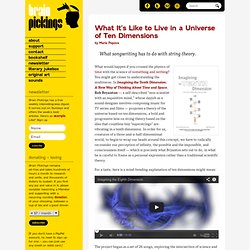
What would happen if you crossed the physics of time with the science of something and nothing? You might get closer to understanding the multiverse. In Imagining the Tenth Dimension: A New Way of Thinking About Time and Space, Rob Bryanton — a self-described “non-scientist with an inquisitive mind,” whose dayjob as a sound designer involves composing music for TV series and films — proposes a theory of the universe based on ten dimensions, a bold and progressive lens on string theory based on the idea that countless tiny “superstrings” are vibrating in a tenth dimension. Alice in Quantumland: A Charming Illustrated Allegory of Quantum Mechanics by a CERN Physicist. By Maria Popova Down the rabbit hole of antimatter, or how to believe six impossible things about gender stereotypes before breakfast.

As a lover of science and of all things Alice in Wonderland, imagine my delight at discovering Alice in Quantumland: An Allegory of Quantum Physics (public library) — an imaginative and unusual 1995 quantum primer by particle physicist Robert Gilmore, who has under his belt experience at Stanford and CERN. Ramesh Raskar: Imaging at a trillion frames per second.
Top Four 'Higgs Boson Explanations' What Today's Higgs Boson Discovery Really Means. The boson series, in short and somewhat muddied recollection of the subject.
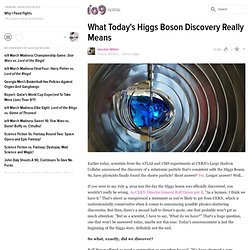
Please do your own research if you want a fully accurate description, google and wikipedia are great places to start, cassiopea project has a video series on the standard model that explain it pretty well too. The term 'boson' is a concatenation of Bose-Einstein, representing physical properties which are very alien to what we normally observe. The matter we can see is Newtonian, meaning it follows Newton's laws of physics. What is a Higgs Boson? What Is the Higgs? - Interactive Graphic. The Higgs Boson Explained.
Integral challenges physics beyond Einstein. Integral challenges physics beyond Einstein Gamma-ray burst 30 June 2011 ESA’s Integral gamma-ray observatory has provided results that will dramatically affect the search for physics beyond Einstein.
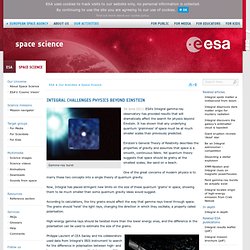
It has shown that any underlying quantum ‘graininess’ of space must be at much smaller scales than previously predicted. Leonard Susskind’s Online Lectures. On the Origin of Gravity and the Laws of Newton. "Just a Theory": 7 Misused Science Words. Eric Weinstein may have found the answer to physics' biggest problems. Two years ago, a mathematician and physicist whom I've known for more than 20 years arranged to meet me in a bar in New York.

What he was about to show me, he explained, were ideas that he'd been working on for the past two decades. As he took me through the equations he had been formulating I began to see emerging before my eyes potential answers for many of the major problems in physics. It was an extremely exciting, daring proposal, but also mathematically so natural that one could not but feel that it smelled right.
Quantum Art and Poetry. What is the Uncertainty Principle? Heisenberg's Uncertainty Principle Explained. CERN: The Standard Model Of Particle Physics. The Uncertainty Principle. Scientists Discover a Jewel at the Heart of Quantum Physics - Wired Science. F2.large.jpg (JPEG Image, 1280 × 929 pixels) Margaret Wertheim – The limits of physics. Theoretical physics is beset by a paradox that remains as mysterious today as it was a century ago: at the subatomic level things are simultaneously particles and waves.
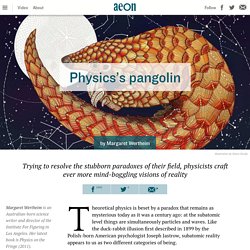
Like the duck-rabbit illusion first described in 1899 by the Polish-born American psychologist Joseph Jastrow, subatomic reality appears to us as two different categories of being. But there is another paradox in play. Physics itself is riven by the competing frameworks of quantum theory and general relativity, whose differing descriptions of our world eerily mirror the wave-particle tension. When it comes to the very big and the extremely small, physical reality appears to be not one thing, but two. Where quantum theory describes the subatomic realm as a domain of individual quanta, all jitterbug and jumps, general relativity depicts happenings on the cosmological scale as a stately waltz of smooth flowing space-time. Many physicists are Platonists, at least when they talk to outsiders about their field. Explore Aeon.